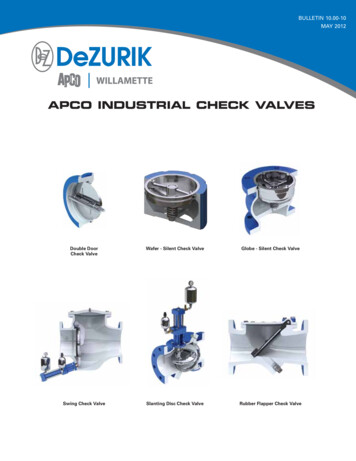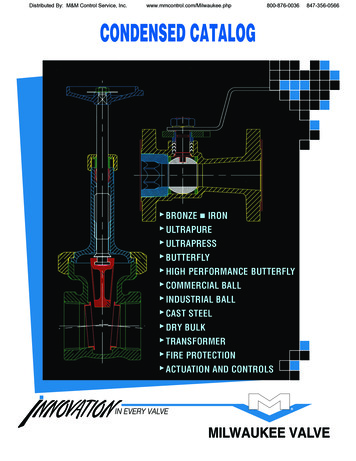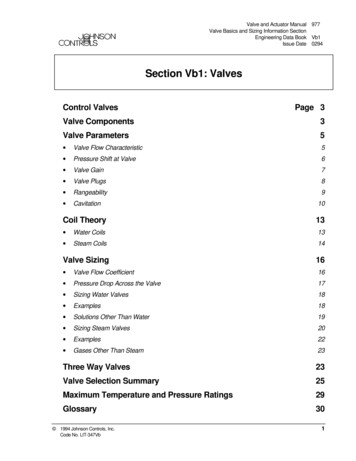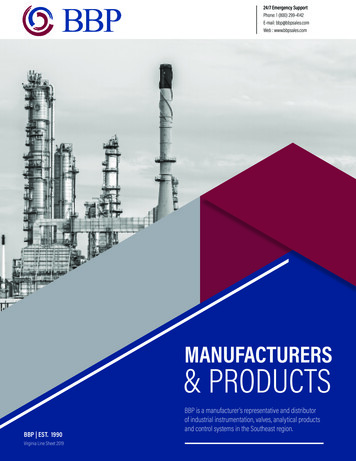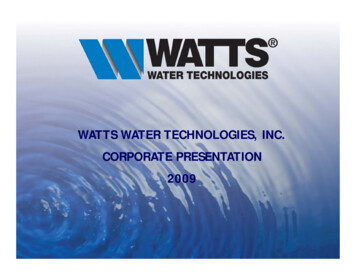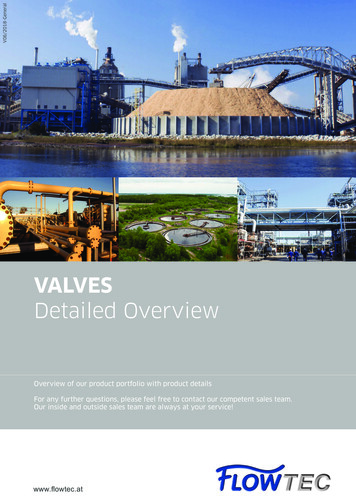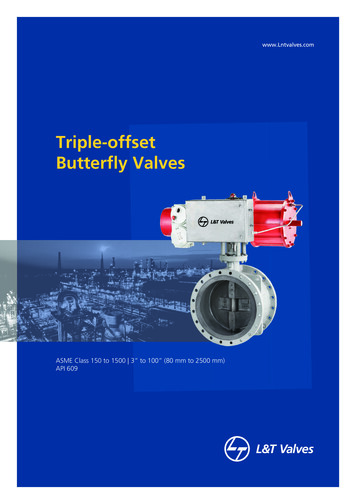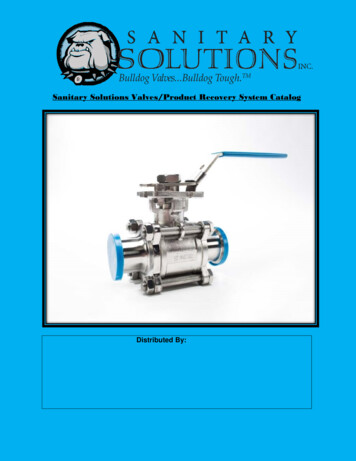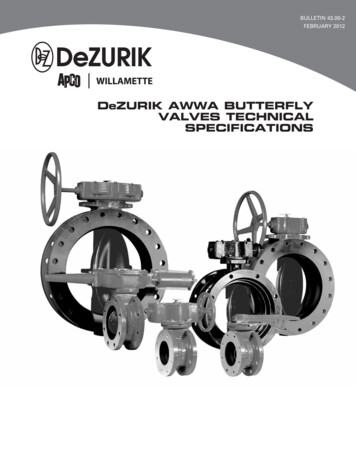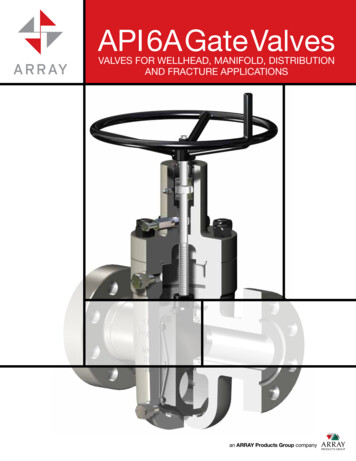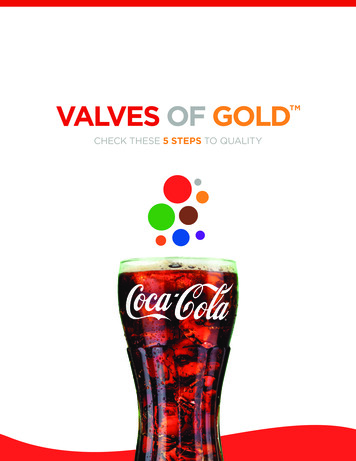
Transcription
VALVES OF GOLD CHECK THESE 5 STEPS TO QUALITY
5 STEPS TO SOFT DRINK QUALITY1ROTATION.3It’s got to be fresh to taste just right.How to Change a BIB (Bag-in-Box).42REFRIGERATION.5If the drink isn’t cool, it melts too much ice and loses its fizz.Ice-Cooled Refrigeration.6Mechanical Refrigeration.7Remote Refrigeration.83CARBONATION.9A good soft drink has the sparkling fizz of proper carbonation.How to Change an Empty CO2 Cylinder. 11Checking the CO2 Pressure Regulators. 12How to Check for a CO2 Leak. 134 PRESENTATION. 14Who wants a soft drink from a dispenser that’s not clean?5SENSATION. 16Be your own first customer! You know how good Coca-Cola fountainbeverages should taste.WATER ADVISORY. 18Start-Up Procedures after Boil Water AdvisoryHELP!. 20What’s That in Your Soft Drink Dispensing System?.20Ice-Cooled System Components. 21Mechanical Refrigeration Systems. 22Remote Refrigeration Systems. 23Coca-Cola Customer Care Center. 24Spot Checks. 25Troubleshooting Guide.26Quality Assurance Kit. 32COCA-COLA CUSTOMER CARE CENTER1-800-241-COKE (2653)2
STEP 1ROTATIONFirst In.First Out!FRESH!WHY IT’S IMPORTANTARemember, great taste is why your customer orders a soft drink.Your customers expect to be served great-tasting fresh products.Fresh syrup is essential to producing great-tasting soft drinks.WHAT TO CHECKSyrups produced by The Coca-Cola Company for your soft drinksystem are packaged in Bag-in-Box containers. To make certain youalways serve only fresh syrup, pay attention to these conditions 1Check the date code. Each syrup container is stamped with a date .code indicating the “Enjoy By” date. The date code is on a labelaffixed to the box.2Rotate your syrup stock. Always use the oldest syrup first tomaintain freshness. Remember FIFO.first in, first out (photo A)!(See page 4 for How to Change a BIB [Bag-in-Box])3Avoid using syrup that is too old. Syrup should be used before“Enjoy By” date.4Soak the syrup line connector weekly or when changing BIBs.Soak connectors in chlorine-based sanitizer solution for 1 minute,and reconnect to the correct Bag-in-Box (photo B).SAFETY PRECAUTIONS Never stack Bag-in-Box containers more than 5 high for5 gallons. For 2.5 gallons, never stack containers morethan 10 high. Be sure containers are stored at least6 inches off the floor (photo C). Never store near heat source, chemicals, pesticides, etc. Never store outside or in cooler.BC3
HOW TO CHANGE A BIB (BAG-IN-BOX)1Unscrew the syrup line connector and remove the empty box(photo A).2Open the flap of the new box by hitting it sharply with your palm.DO NOT use a sharp instrument (photo B)!3Pull the bag connector through the opening and remove the plasticdust cap (photo C).4Soak connectors in chlorine-based sanitizer solution for 1 minute(photo D).5Reconnect to the correct Bag-in-Box. Tighten until the connectorsare fully engaged (photo E).6Operate the dispensing valve to restore syrup flow (photo F).ABCDEF4
STEP 2REFRIGERATIONHow cool? 40 F or less!COOL!WHY IT’S IMPORTANTIf the drink is warmer than 40 F when it is dispensed It tends to foam losing its carbonation and producing aflat-tasting beverage. It quickly melts ice resulting in a weak, watery-tasting beverage.ATo make sure your soft drinks are cool enough, check drinktemperature daily. Just follow these simple steps FIRST SEE IF THE THERMOMETER IS RIGHT!12Test the thermometer accuracy. Place the thermometerin a full cup of ice with water added. Stir until the temperaturereading remains constant. It should read exactly 32 F(photo A). Does it?BAdjust the thermometer. Locate the adjustment nut underthe dial. With the thermometer inserted in the cup of ice water,turn the adjustment nut with an adjustable wrench until the dialneedle points directly at 32 F (photo B).THEN CHECK DRINK TEMPERATURE!3Get cool product to the valve. If the valve has not been operatedin the last thirty minutes, dispense a 20 ounce drink without iceand pour out (photo C).4Dispense a test drink. Draw a second drink without ice for testingdrink temperature. Insert the thermometer and stir gently while nottouching the sides of the cup (photo D).5CRead the temperature. After 15 seconds, the drink temperatureshould be less than or equal to 40 F (photo E). If not, the causeshould be identified and corrected. (See page 6 for Ice-CooledRefrigeration or page 7 for Mechanical Refrigeration or page 8for Remote Refrigeration. In addition, refer to the TroubleshootingGuide in the Help section.)5
A. ICE-COOLED REFRIGERATIONHOW IT WORKSMany soft drink dispensing systems use ice to cool the beverage.Ice-cooled refrigeration relies on a cold plate, which is usually locatedon the bottom of the ice bin (photo F).WHAT TO CHECKIf the drink temperature from your ice-cooled refrigeration system isabove 40 F, check the following conditions IS THE ICE BIN FULL ENOUGH?The cold plate works best when it’s COMPLETELY covered with ice.As a general rule, you should keep your ice bin 1/3 full at all times forproper cooling (photo G).IS THE ICE BIN DRAINING PROPERLY?The cold plate works poorly if the water from melting ice doesn’t drain away.IS THE ICE IN CONTACT WITH THE COLD PLATE?You should stir the ice periodically throughout the day to make sure iceis always in direct contact with the cold plate. Stirring breaks up gapscalled “ice bridging” (photo H).DEFGH6
B. MECHANICAL REFRIGERATIONSome soft drink dispensing systems use a compressor to cool thebeverage. This type of mechanical refrigeration unit may be locatedin the dispenser cabinet or in a remote location.HOW IT WORKSA water bath inside the refrigeration unit is cooled to form ice,which melts as it keeps the syrup and carbonated water chilled.The compressor starts whenever more ice is needed and shutsoff when enough ice has been made.WHAT TO CHECKIf the drink temperature from your mechanical refrigeration systemis above 40 F, check the following conditions IS THE REFRIGERATION UNIT NEAR A HEAT SOURCE?A mechanically cooled refrigeration system should NEVER be locatednear any major source of heat (ovens, grills, heaters, etc.).IS THE AIR FLOW TO THE COMPRESSOR BLOCKED?Cool air enters the front of the compressor, and warm air escapes fromthe top. If either air flow is blocked, the compressor will overheat andfail. Keep the front and top of the compressor clear at all times.IS THE REFRIGERATION UNIT PLUGGED IN?Check to be sure the unit is properly plugged in and that a circuitbreaker has not been tripped.7
C. REMOTE REFRIGERATIONSome soft drink dispensing systems use a compressor system in the backroom to cool carbonated water and syrup and a recirculating system tokeep the carbonated water and syrup cool between the remote compressorsystem and dispenser valves in the dispensing area (photo A).HOW IT WORKSA water bath inside the remote refrigeration unit is cooled to form icewhich melts as it keeps the syrup and carbonated water chilled. Thecompressor starts whenever more ice is needed and shuts off whenenough ice has been made.AA separate motor and pump recirculate chilled carbonated water inthe insulated lines between the compressor system remote unit anddispensers to keep the syrup cool (photo B).WHAT TO CHECKIf the drink temperature from your dispensing valves is above 40 F,check the following conditions BIS THE UNIT OR ARE INSULATED LINES NEAR A HEAT SOURCE?The refrigeration unit or insulated lines should never be near a majorsource of heat (ovens, grills, heaters, exhausts in the attic, etc.).IS THE INSULATED SYRUP AND WATER TUBING INTACT ANDWELL-INSULATED AT ALL POINTS?Insulation is critical where the lines connect to the dispensing towersor the refrigeration unit. If the insulated tubing is not wrapped at thesepoints or is exposed to air at other places, the line may become filledwith condensed water from the air. This will cause the water and syrup inthe lines to heat up. Only a service technician can correct the problem.IS THE AIR FLOW TO THE COMPRESSOR BLOCKED?Cool air enters from one side of the compressor and warm air escapesfrom another side. If either air flow is blocked, the compressor willoverheat and fail. Keep both air flows clear at all times. Whether thecompressor is located inside or outside the restaurant, it is necessary toensure that the air flow remains unobstructed.IS THE COMPRESSOR SYSTEM PROPERLY CONNECTED TOTHE ELECTRICAL POWER SOURCE?Ensure that the unit is plugged in and/or the circuit breaker has notbeen tripped.8
STEP 3CARBONATIONBUBBLES!Bubbles! Fizz! Carbonate!AProper carbonation comes from the right amountof carbon dioxide (CO2) gas being mixed withwater in your soft drink system.HOW IT WORKSA CO2 cylinder contains liquid Carbon Dioxide under high pressure(photo A). As gas from the top of the cylinder flows out and mixeswith water to make carbonated water, the amount of liquid in thecylinder is gradually reduced.BA Bulk Tank system is similar in use to a CO2 cylinder system buttypically contains 200 to 400 lbs. of liquid Carbon Dioxide and isunder less pressure (photo B). The bulk tank is typically filled by yourCO2 supplier so tank changing is unnecessary.WHAT TO CHECKIf your drink is flat or less carbonated than it should be, check to see IS THE TANK FULL?You can tell a tank is empty by observing the 0 to 2000 PSI gauge(photo C). There are several types of gauges; some will have a redpie-shaped section indicating a tank change is required. Other tankswill have a red bar area. Some tanks will not have any markings;change these tanks when the pressure is under 500 PSI.If you have a bulk CO2 tank, you need to locate the contents gauge ontop of the tank (photo D). Typically it looks like a gas gauge oran upside-down test tube. It should be above 1/4 full. Find the tankpressure gauge. If this gauge reads 120 PSI or less, the tank does nothave enough pressure to push CO2 . If the content gauge is below1/4 full or the tank pressure gauge is less than 120 PSI, then call yoursupplier for a refill or for tank service.CD9
IS THE VALVE OPEN?This is easy to check on CO2 cylinders, and it’s amazing how oftensomeone forgot to open the valve! A simple screw-type valve opensand closes the tank. Turn the valve to the left to open the tank and to the rightto close the tank (photo A). Always open the valve completely when using the tank and closethe valve when the tank is not in use. This stops CO2 from leakingaround the valve stem.AIS THE PRESSURE SET CORRECTLY?If the pressure isn’t right, the carbonation won’t be right! Check thehigh pressure regulator and the low pressure regulator settings(photo B). Some of the latest regulator technology comes preset anddoes not require gauges (photo C). See Page 12 for instructions onchecking these pressure regulators.BWARNING!CO2 IS HIGH PRESSURE STUFFPay attention to these SAFETY PRECAUTIONS: Keep CO2 cylinders standing upright! They must be stored and used in the upright position at all times(photo D). Laying a CO2 cylinder down could cause damage to thevalve, resulting in a dangerous, out-of-control gas leak. Keep CO2 cylinders in a well-ventilated area! Because carbon dioxide displaces oxygen, you want to be certainit doesn’t build up in the storage area. Keep CO2 cylinders secured to the wall! Each CO2 cylinder contains 700 to 1200 pounds per square inch(PSI) of stored pressure. You don’t want one falling down! Use achain or bracket positioned 1/3 of the way down from the top tosecure ALL cylinders. This means “in use,” ”back up” and“empty” cylinders! Keep CO2 cylinders at room temperature! If the temperature goes up, so does the pressure inside thecylinder. Keep CO2 cylinders away from heat to avoid excessivepressure buildup.WHEN TO SUSPECT A CO2 LEAKCDThis chart shows typical CO2 usage for a well-maintained soft drinkdispensing system.Tank SizeAmount ofLiquid CO2Produces enoughto carbonate20 pounds20 poundsFive 5-gallon boxes or Ten 2.5-gallon boxes50 pounds50 poundsTwelve 5-gallon boxes or Twenty-four 2.5-gallon boxesIf your system seems to be using more CO2 than normal, it’stime to check for a leak! (See page 13 for How to Check for aCO2 Leak.)10
HOW TO CHANGE AN EMPTY CO2 CYLINDERWhen a CO2 tank is empty, follow these simple steps to changethe tank.1Close the empty tank. Turn the valve completely to the right(photo A).2Loosen the connection nut. Use a CO2 wrench or box end wrenchONLY. Slowly turn the large nut to the left (counterclockwise).Pause briefly to allow pressure to escape (photo B).3Unfasten the hose. Unscrew the large nut the rest of the way.4Replace the tank. Unfasten the chain or bracket securing the emptytank, then move it and secure it upright in a storage area. Place thenew tank in position, and secure it with the chain or bracket.5Check the connection. Inspect the connection on the new tank fordamage or debris. Briefly open the tank valve a little bit to blowout any hidden debris (photo C).6Check the seal. Inspect the sealing O-ring inside the large nut fordamage or debris. If your connection uses a sealing washer,replace it with a new one (photos D & E).7Connect the new tank. Fasten the large nut, fitted with the O-ringor sealing washer, to the new tank. Tighten the nut with the wrench(photo F).ABCDEF11
CHECKING THE CO2 PRESSURE REGULATORSThe High Pressure Regulator (photo A) controls the amount of CO2gas your system uses to make carbonated water. Your High Pressuregauge should be set at 105 PSI for standalone carbonators, 95 PSI forremote refrigeration carbonators and 75 PSI for Bevariety dispensersand cold carbonators in counter electric units.AThe Low Pressure Regulator (photo B) controls the pressure of theCO2 gas your system uses to move syrup from the Bag-in-Box to thedispenser. The Low Pressure Regulators are usually mounted near thesyrup supply. Your Low Pressure Regulator gauge should be set at65 PSI, unless the syrup is pumped up from BIBs in the basement(should be set at 70 PSI).Check the reading on the CO2 pressure regulator gauges to see ifthey match the correct settings for your soft drink system.BIf your regulators don’t have visible gauges, you can order an accurategauge (part #20953) through the small parts program. Check thepressure using the same technique as with automobile tires. (photo C)Call 1-800-241-COKE (2653) to get help if any regulators are not setto the correct pressure.C12
HOW TO CHECK FOR A CO2 LEAKARE YOU LOSING CO2?A 20-pound CO2 cylinder contains 20 pounds of liquid carbondioxide and should supply enough carbonated water for approximately5 boxes of syrup.A 50-pound CO2 cylinder contains 50 pounds of liquid carbondioxide and should supply enough carbonated water forapproximately 12 boxes of syrup. If your system seems to be usingtoo much, check for a leak by following these simple steps.1Turn off the CO2 supply. Turn the valve completely to the right toshut off pressure to the system (photo A).NOTE: Be sure NO ONE operates the dispenser while you arechecking for a CO2 leak.2Check the gauge. Observe the pressure reading on the 0 to 2000PSI gauge (photo B).If the pressure settles and remains constant, there are no leaks.If the pressure steadily drops, there is a leak in the system.WHAT TO DOCall the Coca-Cola Customer Care Center toll free at1-800-241-COKE (2653) if You have a CO2 leak You need to adjust your CO2 regulator or your gauges are broken You cannot read your gaugesAB13
STEP 4PRESENTATIONCLEAN!AYour customers associate a clean, tidy area with quality.WHY IT’S IMPORTANTBKeeping your dispensing system clean helps keep it operatingproperly. A clean, sanitary appearance communicates quality toyour customers.WHAT TO DOIt’s easy to keep your dispensing area clean and orderly when youfollow this regular schedule of activities.CDAILY1Clean the dispensing valve. Wash your hands with soap and water,and prepare a 2.5-gallon chlorine-based sanitizer solution. Removethe nozzles and diffusers from the dispensing valves and cleanthem in sanitizer solution with a nozzle brush, and place them insanitizer solution for at least 3 minutes (photo A). Then removethem and let them air dry. Then clean the lower valve body with abrush and sanitizer solution (photo B). Wash your hands with soapand water, and reinstall nozzles and diffusers. Do not run nozzles,diffusers or drip tray through a dishwasher.2Clean the drip pan. Pour 1/2 gallon of chlorine-based sanitizersolution over the cup rest and down the drain (photo C). Removerack. Wipe down inside/outside of the drip pan with a clean clothtowel and chlorine-based sanitizer solution (photo D).3Clean the dispenser. Clean all exterior surfaces of the dispenser,including levers with a clean cloth towel and chlorine-basedsanitizer solution (photo E). If Drop-In, empty ice bin and pourin a 1/2 gallon of sanitizer solution. Wipe dry. If Bar-Gun, followthe above steps, then remove and clean nozzle and diffuser witha dedicated brush and sanitizer solution. Let them air dry andreinstall nozzle. If Ice Combo, clean the ice chute with a brushand chlorine-based sanitizer solution (photo F).4Document and sign the Dispenser Sanitizing Inspection Log(photo G).DEFG14
WEEKLY1Clean Syrup Connectors. Wash your hands with soap and water,and prepare a 2.5-gallon chlorine-based sanitizer solution.Disconnect syrup line from Bag-in-Box. Soak connectors in adedicated bucket of sanitizer solution for 1 minute. It’s OK tosoak multiple connectors at the same time if they are markedwith a flavor label. Reconnect syrup lines to correct BIB.MONTHLY1Clean the inside of ice bins. Wash hands with soap and water, and .prepare a 2.5-gallon chlorine-based sanitizer solution. Unplug thedispenser. Empty all ice and rinse ice bin with warm water. Applysanitizer solution using a soft, long handle nylon bristle brush toscrub inside of ice bin and chute. DO NOT USE a metal brush.2Clean the condenser (mechanical refrigeration). Unplug thedispenser and remove the grill cover in front of the condenser.Use a vacuum hose with a soft brush attachment to gently cleanthe exposed surface of the condenser. Brush in the same directionas the aluminum fins. To avoid bending the fins and blocking airflow, DO NOT push hard!3Clean the condenser filter (mechanical refrigeration). If yourcondenser is equipped with a foam filter, the above step is notnecessary. Instead, remove the foam filter and wash it in asoap-and-water solution. Rinse completely and allow to dry on aflat surface. Reinstall the foam filter when totally dry.NOTE: Do NOT stack cups, boxes or other materials on top of oraround the dispenser’s ventilation area. Blocking the condensercan cause improper cooling. Do NOT store items in ice bin ofdrop-in dispensers as this could cause contamination.4Maintain product labels. Check all dispensing valves and replaceany labels that are damaged or incorrect.5Check Water Filters to ensure they are current.15
STEP 5SENSATIONThe unique, refreshing flavor ofCoca-Cola Fountain soft drinks!TASTE!AWHY IT’S IMPORTANTGreat taste is why a customer buys a soft drink! To make sure youdispense only great-tasting soft drinks, you should taste test eachproduct daily. Dispense a sample and taste it carefully. It should becompletely free of any “off-taste” or unpleasant odors (photo A).WHAT TO CHECKIf you detect any “off-taste” in the soft drinks you dispense or if theytaste too syrupy or too watery, check the following conditions DO YOU NEED A WATER FILTER?BIf your soft drinks taste or smell like chlorine, your dispensing systemmay require installation of a water filter. Call 1-800-241-COKE (2653)for information on water testing and assistance in locating anauthorized water filter company (photo B).HAS YOUR WATER FILTER EXPIRED?If you have a water filter, check to see if the filter cartridge is out-of-dateor on “by-pass.” Replace any expired filter cartridge with a new one.ARE YOU USING FRESH SYRUP?Check to see that syrup is not out-of-date and is being properlyrotated (photo C). (See page 3 to Make Sure the Syrup is Fresh!)C16
ARE THE DISPENSING VALVES CLEAN?Dispensing valve nozzles and diffusers and lower valve body (photo D)should be cleaned DAILY to avoid unsanitary conditions that can causebad-tasting drinks. (See page 14 for Dispenser Cleaning andSanitizing Procedures.)ARE YOU USING THE RIGHT TYPE ANDAMOUNT OF ICE?DThe right kind and right amount of ice add a lot to the consumers’enjoyment of a quality soft drink. The ice should keep the drink coldwithout melting too fast and diluting the beverage.WHAT TO DO1Use the right kind of ice. Use only the kind of ice recommendedfor your soft drink dispensing system (photo E). Never use baggedice, as it causes foaming and can damage your ice dispenser.2Use the right amount of ice. Always serve the amountrecommended for the size drink you are dispensing. If you usehard cube ice, fill the cup 1/3 full with ice.3Always serve ice with an ice scoop. It’s sanitary.4Keep your ice bin closed. Make sure the lid is on when not in useto prevent melting. This will also protect against anythingaccidentally being dropped into the ice bin.5The ice bin is for ice ONLY. Never store food products, icescoop, bottles, juice boxes, etc. in your ice bin. They couldcontaminate the ice.E17
WATER ADVISORYSTART-UP PROCEDURES AFTER BOILWATER ADVISORYPurpose: The purpose of this procedure is to assistcustomers with flushing and sanitizing equipment after aBoil Water Advisory. This procedure should only beperformed AFTER the Boil Water Advisory has been lifted.EQUIPMENT TO BE CONSIDERED:Postmix and premix fountain dispensers, juice machines, icemakers,frozen carbonated beverage dispensers and any other water-usingappliances such as brewing equipment, filter housings and cartridges.Destroy All Ice Made Prior to or During The Boil Water Advisory From icemaker bin(s)From fountain dispenser bin(s)Any other ice bin(s)Obtaining a Safe Water Source Approved by City Officials1Flush incoming water line Open cold water side of a hand sink for a minimum of30 minutes.2Flush all water lines in building Open all other cold water faucets for a minimum of 5 minutes.Equipment Start-UpNOTE: Any water filters supplying beverage or ice equipment mustbe replaced prior to any dispensing equipment being restarted.If a Coca-Cola Managed Filtration Program is in place, call1-800-241-COKE (2653) to confirm that a technician will bedispatched to replace filter cartridges.If an Ecolab Managed Filtration Program is in place, call CustomerService at 1-800-352-5326 to initiate emergency service by Ecolab’sService department.18
Customer-Maintained FiltersFollow these steps to replace water filters before restartingdispensing equipment: Water filter(s) must be replaced prior to any other Equipment Start-Up.Run water from flush (activation) valve to drain for 5 minutes.Remove and discard water filter cartridge(s).Follow the sanitation procedures recommended by your waterfilter manufacturer to sanitize and clean water lines from filter todrink valves.Replace water filter cartridge(s).Any system that is without a new water filter cartridge must not beplaced back in service.Reverse-Osmosis Systems Sanitize system as recommended by manufacturer – includestorage tanks. Contact your water treatment provider for this service.Icemakers Run two complete ice-making cycles and discard all the ice made. Sanitize icemaker bin.Fountain Dispensers Sanitize ice bin if present. Run each beverage valve on each dispenser for at least 2 minutes twice. For Coca-Cola Freestyle, run a carbonated and non-carbonated beveragefor 2 minutes. Taste all drinks. If there is an off-taste from any valve, flush the valve foranother minute, then check again for satisfactory taste. If taste remainsunsatisfactory, place a service call.Frozen Beverage Dispensers Discard all products in the dispenser(s). Place a call for service.Juice Machines Flush water through unit for at least 5 minutes on first flavor. Flush water through any additional flavors on same unit for at least 1 minute.Coffee Makers / Tea Brewers Brew at least 4 pots of hot water per unit.If the effectiveness of any procedure is in doubt at any time during theflushing process, the procedures should be repeated in their entirety.While these are recommended procedures, they do not guarantee that equipment will be safe touse if followed. It is the customers’ obligation to ensure that:(i) these procedures are appropriate and effective; and(ii) equipment is safe and ready to resume normal operations after a Boil Water Advisory.19
HELP!WHAT’S THAT IN YOUR SOFT DRINKDISPENSING SYSTEM?It’s helpful to think of your soft drink dispensing system as a sort of“mini-factory” designed to produce finished beverages of high quality.The system cools syrup and carbonated water and mixes them in thecorrect ratio at the dispensing valve.Your dispensing system manufactures quality soft drinks in a simple4-step process:1Water and carbon dioxide (CO2) gas are mixed in a carbonator toproduce carbonated water.2The carbonated water is cooled in the refrigeration unit on itsway to the dispensing valve.3Syrup is cooled in the refrigeration unit on its way to thedispensing valve.4The dispensing valve is set to mix the carbonated water and syrupin the correct ratio, producing a perfectly mixed drink with atemperature equal to or less than 40 F.20
15001000 5000657210912ICE-COOLED SYSTEM COMPONENTS1Min. 1/2" Water Supply with Shut-off Valve; Minimum 40 PSIwater pressure2 Dedicated, 115-volt, 20-amp, grounded duplex outlet3 Carbonator4 Carbonated Water Feed Line5 CO2 Cylinder or Bulk Tank6 CO2 Regulators: High and Low Pressure7 5-Gallon or 2.5-Gallon Bag-in-Box Syrup Containers8 Bag-in-Box pumps: one for each flavor9 Syrup lines from BIB to dispenser10 Ice Bin with Cold Plate11 Dispenser12 Approved 3 inches or larger floor drain within 3 feet of dispenser21
000 5000657MECHANICAL REFRIGERATION SYSTEMS123456789Min. 1/2" Water Supply with Shut-off Valve; Minimum 40 PSIwater pressureDedicated, 115-volt, 20-amp, grounded duplex outletCarbonatorCarbonated Water Feed LineCO2 Cylinder or Bulk TankCO2 Regulators: High and Low Pressure5-Gallon or 2.5-Gallon Bag-in-Box Syrup ContainersBag-in-Box pumps: one for each flavorDispenser22
FILLSTOPFILLSTOPFILLWATER412REMOTE REFRIGERATION SYSTEMS12345CO2 Cylinder or Bulk TankRemote Unit with Carbonator built inInsulated Water and Syrup LinesDispenser5-Gallon or 2.5-Gallon Bag-In-Box Syrup Containers23
COCA-COLA CUSTOMER CARE CENTERSave time and avoid a service call by using the Coca-ColaCustomer Care Center. Call 1-800-241-COKE (2653), the fastestsoft drink dispenser repair service available!The Coca-Cola Customer Care Center is your direct line totechnical advice and phone troubleshooting procedures.The Coca-Cola Customer Care Center is staffed 24 hours a day,7 days a week.Customer Service Representatives will help determine if the problemcan be solved by phone. If so, a certified, experienced Coca-Colatechnician will help you fix your beverage equipment over the phone(Phone Fix ) so you can quickly begin serving beverages again. It iseasy, fast and free. If a service call is needed, an authorized serviceagent in your area will be dispatched immediately. In many instances,the Coca-Cola Customer Car
2 cylinders, and it’s amazing how often someone forgot to open the valve! A simple screw-type valve opens and closes the tank. Turn the valve to the left to open the tank and to the right to close the tank (photo A). Always open the valve completely when using the tank and c
